Skiing into a Future Affected by Climate Change
Written on
In a recent article from the Daily Mail, a professor I was unfamiliar with from a lesser-known university claimed we won't see another ice age for 50,000 to 100,000 years. I was skeptical; after all, the Daily Mail often seems akin to the National Enquirer—more suited for lining birdcages than serious journalism.
Just days ago, I published a piece titled Brits, Get Out Your Long Underwear, Climate Change is Bloody Nasty. I intended to discuss the Gulf Stream's collapse alongside Milankovitch cycles, but the narrative grew too lengthy, and I lost focus.
This brings us to a crucial point: Milankovitch cycles refer to the Earth's periodic shifts in its orbit around the sun, which have contributed to ice age cycles over the last 2.8 million years. To understand why these patterns began, we need to examine 500 million years of climate data.
Can we prevent the next ice age? I could leave that as a question for you to ponder, but I’ll provide some insights instead.
Milankovitch Cycles
About a century ago, Serbian geophysicist and astronomer Milutin Milankovi? theorized that variations in the Earth’s climate could be explained by changes in its orbital eccentricity, axial tilt, and precession. These cycles combine to produce cyclical shifts in solar radiation reaching the planet's surface.
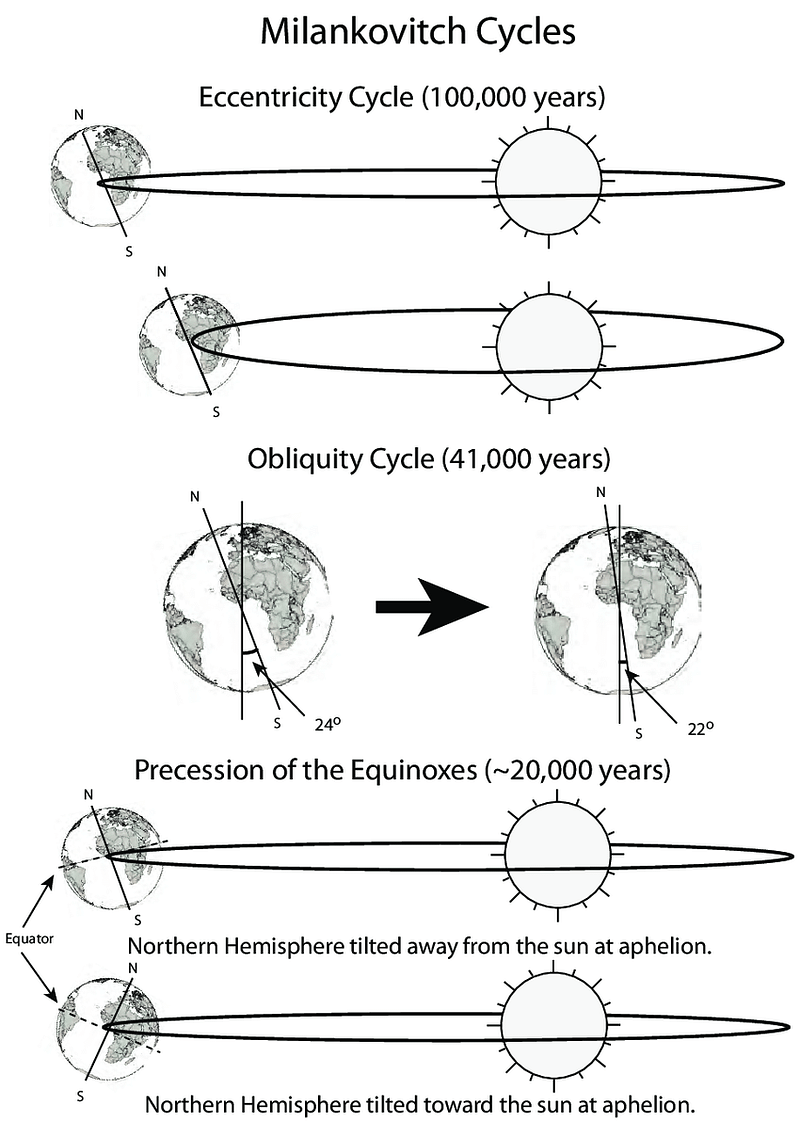
Eccentricity measures how much the Earth’s orbit strays from a perfect circle. Although this variation is slight, it closely aligns with ice age cycles. Axial tilt, or obliquity, determines the angle of the Earth's axis relative to its orbit, influencing seasonal changes. The North Pole traces a circular path in the sky; currently, it points to Polaris, but it pointed to Vega around 12,000 BC, and will return there again in another 12,000 years.
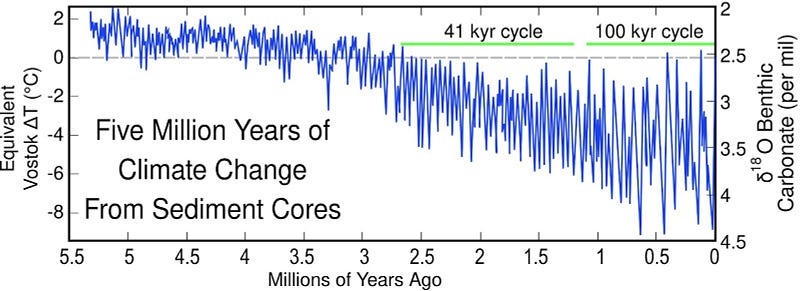
The chart above comes from cores drilled at Vostok Station in Antarctica and other ocean floor sites. The left vertical axis shows temperature deviations from present-day measurements at Vostok, while the dotted horizontal line indicates today's temperature.
The current ice age cycle commenced approximately 2.6 million years ago, defined by two green lines representing 41,000-year and 100,000-year cycles. Until around 1 million years ago, the ice ages followed the 41,000-year obliquity cycle, but then transitioned to the longer 100,000-year eccentricity cycle with occasional obliquity variations.
Why Did the Ice Ages Switch 2.6 Million Years Ago?

The temperature data indicates a consistent decline over the last 50 million years, with average temperatures once nearly 14°C warmer than today. Fluctuations in temperature have corresponded with the obliquity cycle since the Pliocene began 5.3 million years ago, likely even earlier.
Around 2.6 million years ago, temperatures dipped low enough to trigger ice ages. A million years ago, the peaks of obliquity cycles failed to rise sufficiently to end these ice ages, allowing the 100,000-year eccentricity cycle to dominate.
The Role of CO2
Could global warming postpone the next ice age? It’s possible, or it might even trigger it by disrupting the Gulf Stream. While I initially dismissed the Daily Mail's assertion, more credible sources have corroborated it.
> One of the most notable aspects of paleoclimate records is the strong correlation between temperature and atmospheric carbon dioxide levels observed during glacial cycles over the past several hundred thousand years. When CO2 levels rise, temperatures follow suit, and vice versa. This correlation is influenced by the solubility of CO2 in ocean water but primarily reflects a feedback loop between carbon dioxide and climate. Although establishing a clear cause-and-effect relationship remains challenging, changes in glacial climates also involve factors like vegetation shifts and ice sheet extent. — NOAA
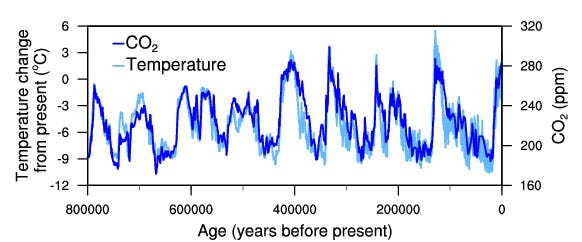
Global temperatures fluctuate with CO2 concentrations. Initially, temperatures may lag behind CO2 increases, but during declines, temperatures tend to lead.
This phenomenon can be partly explained by early temperature rises reducing the Earth’s reflectivity (albedo). For example, lush vegetation replaces snow, while previously arid regions become fertile. Remarkably, just 2,000 years ago, North Africa was known as Rome's granary. As the Earth warmed, greenhouse gases surged, intensifying the warming process.
As the interglacial period wanes, Earth's cycles drift from peak solar insolation, causing deserts to re-emerge and increasing reflectivity. The Gulf Stream may cease, leading to colder, snowier conditions in Europe. An ice-free Arctic Ocean would generate increased precipitation, resulting in heavier snowfall in the Arctic. Snow cover would insulate vegetation, marking the onset of a transition into an ice age.
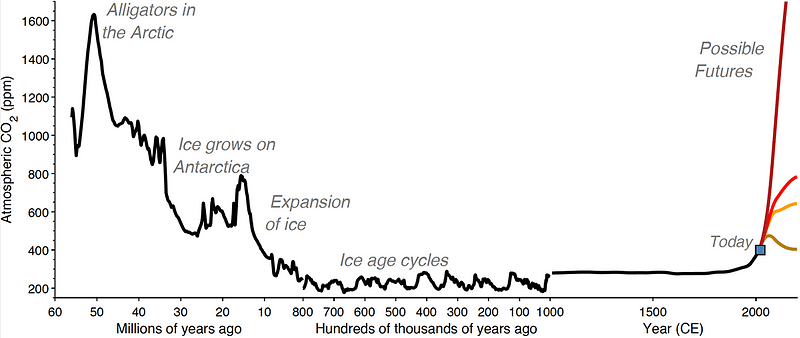
The rise of the Himalayas and the Tibetan Plateau has contributed to CO2 level reductions by increasing weathering of exposed rock, which extracts large amounts of CO2 from the atmosphere.
The Himalayas formed between 40 and 50 million years ago, obstructing monsoon rains from reaching Tibet, which became a desert. This change led to the death of vegetation, exposing underlying rocks to weathering. This uplift coincides with a decline in CO2 levels from the time when "Alligators roamed the Arctic." The planet's temperature has dropped from a previous high of 14°C above today's average, with estimates suggesting a global temperature of 28°C (82°F) during that period.
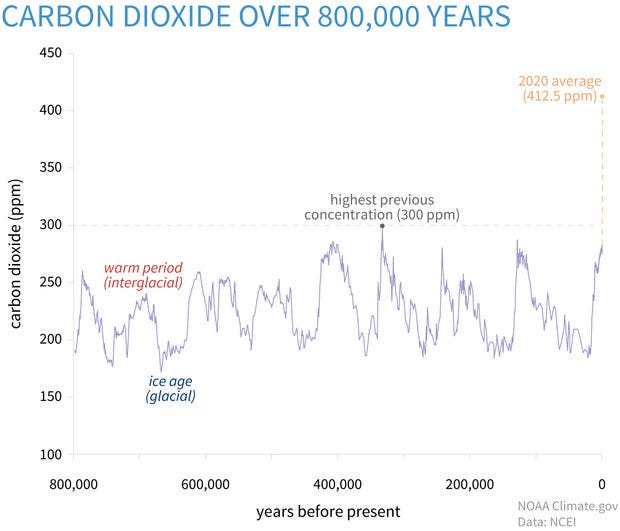
The highest previous interglacial CO2 peak reached 300 ppm, while the lowest was approximately 240 ppm. Recent glacial minima hovered around 180 ppm. The pre-industrial level in 1750 was 280 ppm, equivalent to levels seen at the end of the last ice age.
A decline to 240 ppm CO2 seems to initiate the descent into an ice age, while 280 ppm serves as a critical threshold we should not drop below.
However, we are moving in the opposite direction, with CO2 levels rising alarmingly. Projections indicate we might peak at a CO2 concentration increase, with temperature rises potentially maxing out at 1°C.
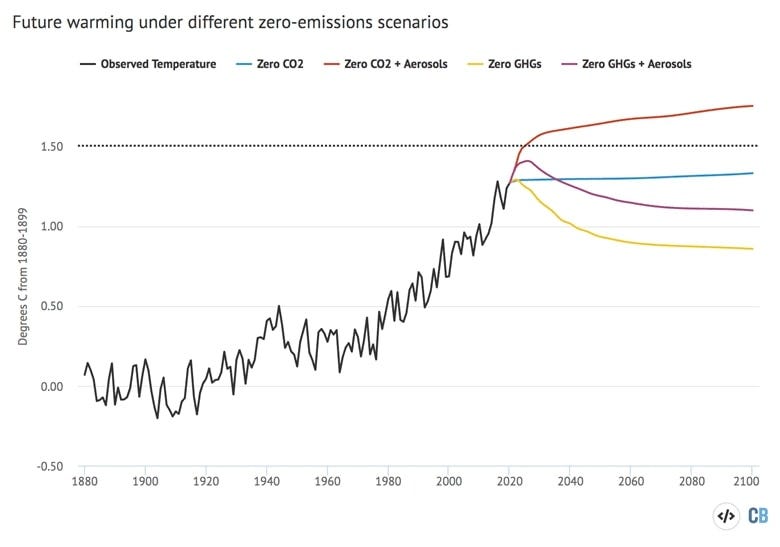
The graph highlights two critical lines: the second from the top (Zero CO2 emissions in blue) and the bottom (Zero Greenhouse Gases in yellow). The upper and third lines incorporate zero aerosols, which are detrimental since aerosols—composed of sulfur and nitrogen—reflect sunlight and cool the planet.
Achieving zero CO2 emissions would stabilize global temperatures at their current levels, while eliminating all greenhouse gases could result in a temperature drop of half a degree by the century's end. Many greenhouse gases are natural and beyond our control.
> Methane emissions arise from various human-influenced and natural sources, including landfills, oil and gas systems, agricultural practices, coal mining, and wastewater treatment. — Importance of Methane, EPA
NASA notes that CO2 remains in the atmosphere for up to a millennium, while other greenhouse gases dissipate within 10 to 15 years but possess a much stronger greenhouse effect. Reducing methane production, particularly from agricultural and human waste, could have a significant impact.
Looking to the Future
Achieving zero carbon emissions as soon as possible is crucial for mitigating impending climate disasters. The prior chart illustrates that with zero carbon emissions, CO2 levels would plateau. However, since we are unlikely to reach zero emissions this year, it’s essential to consider temperature projections based on future emissions.
If we don’t achieve net-zero emissions until 2040 or 2050, temperatures may stabilize closer to a 2°C rise. A model (SSP3) predicts a potential 4°C increase if global cooperation fails.
By 2300, the scenario changes dramatically with potential temperature declines. As global standards of living rise, fertility rates are likely to fall below the replacement rate of 2.1 children. Countries such as China, Russia, the EU, and the US are currently below this rate, with India nearing it. This demographic shift encompasses more than half the global population.
If worldwide fertility trends mirror Japan's rate of 1.4, the global population could dwindle to just over 2 billion by 2300, with CO2 levels returning to pre-industrial figures around 280 ppm.
Even with this decline, it would take a millennium or more before we approach an ice age, and centuries more to reverse climate change.
This provides a unique opportunity to plant resilient vegetation in the Arctic, which absorbs heat better than the barren tundra. We could also consider tree planting in the Sahara to recreate a climate reminiscent of Roman times, along with constructing canals from the Mediterranean to supply water.
Reflections
I initiated this article with a title and image suggesting that the Gulf Stream's shutdown, alongside the conclusion of interglacial Milankovitch cycles, could spark an ice age.
However, my research revealed this premise to be inaccurate, yet I was so fond of the title that I retained it. I apologize for inadvertently falling for my own clickbait.
Ice ages are indeed influenced by Milankovitch cycles and have fluctuated for the past 10 to 15 million years; however, the triggering factor for ice ages is the atmospheric CO2 concentration. Levels below 240 to 260 ppm initiate the onset of an ice age, while levels exceeding 300 ppm can lead to global cooling but not an ice age.
Even if we attain net-zero carbon emissions, it will likely take over a thousand years for CO2 levels to significantly decline. Other greenhouse gases may trap more heat than CO2 but dissipate more quickly.
If the world adopts aggressive CO2 mitigation strategies immediately, the temperature rise could be limited to 1.5 to 2°C. Nonetheless, we would still face severe climate-related disasters and the loss of low-lying island nations and coastal regions. However, we might still manage to protect areas like South Florida and Bangladesh.
Ultimately, measures to prevent CO2 from dropping below 280 ppm are crucial, and initiatives like planting trees in the Sahara and on the Tibetan Plateau are steps we should pursue.
If you join Medium, you get to read stories from thousands of Writers. I receive a portion of your subscription fee at no cost to you. Subscribe.
© Copyright Russell Salsbury